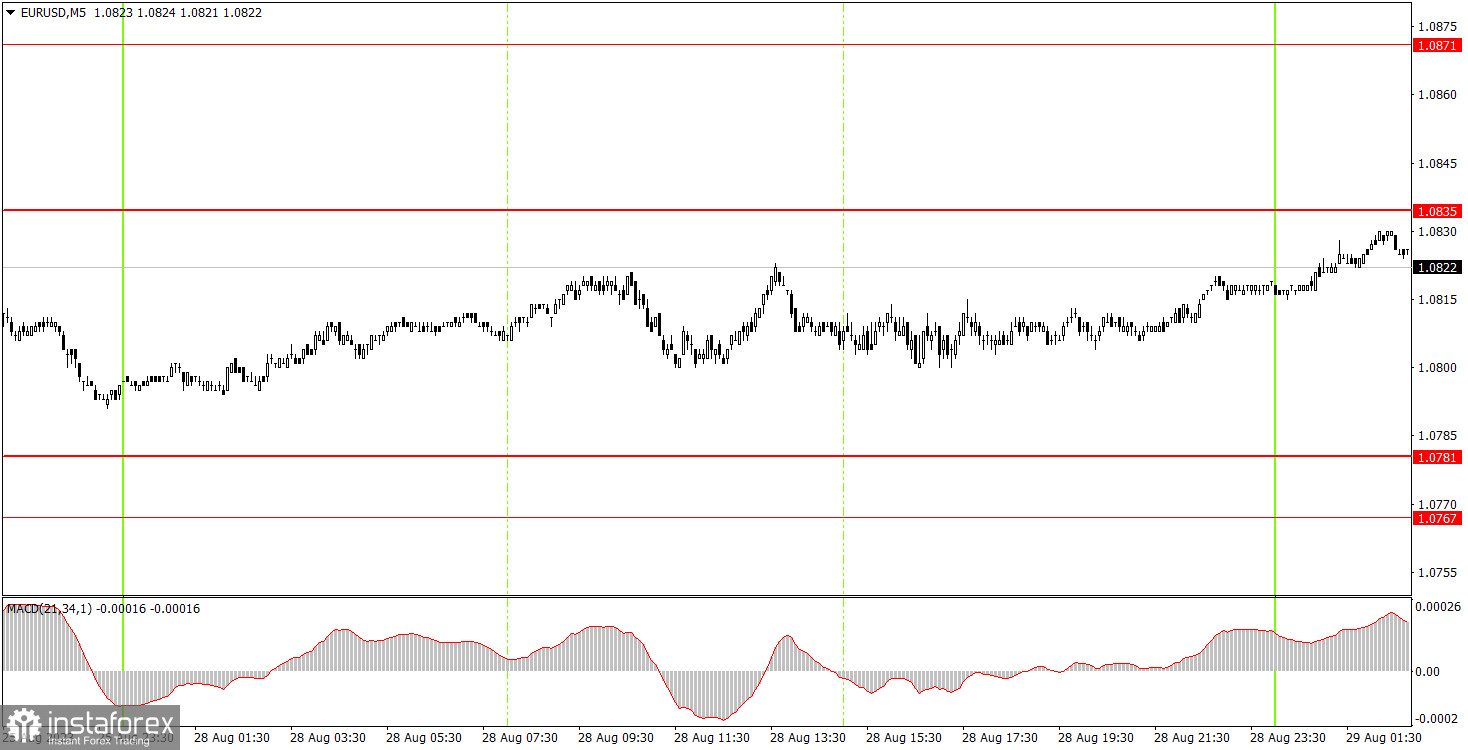Analyzing Monday's trades:
EUR/USD on 30M chart

On Monday, EUR/USD showed sideways trading with low volatility. In general, there is nothing to analyze since the pair moved from its lowest to its highest point by only 29 pips, and this is in the absence of influential economic releases. We presumed that the market might trade in response to Powell's speech in Jackson Hole, but that wasn't the case. As such, the technical picture remains unchanged.
The modest growth should not mislead you. This increase doesn't necessarily indicate the start of a bullish correction. This week, both the US and the European Union will release a significant number of influential economic reports, which could push the pair in any direction. Therefore, drawing conclusions based on Monday's performance is not a productive endeavor. An upward correction is possible, but strong data from the US may fuel the dollar's growth.
EUR/USD on 5M chart

There were no trading signals on the 5-minute chart. The pair strictly moved between the 1.0781 and 1.0835 levels, without even approaching them. The absence of buy or sell signals is a good thing, as with a volatility of 29 pips, earning was nearly impossible. We would like to remind you that any stagnant market condition is generally perceived as a negative thing for traders and is best avoided if possible.
Trading tips on Tuesday:
On the 30M chart, the pair extends its downward movement. From our perspective, the decline of the euro remains the most justified and logical course of action, irrespective of the macroeconomic backdrop. This week, we are looking forward to several reports, so this means that the pair can move in any direction. The key levels on the 5M chart are 1.0673, 1.0733, 1.0767-1.0781, 1.0835, 1.0871, 1.0901-1.0904, 1.0936, and 1.0971-1.0981. A stop loss can be set at a breakeven point as soon as the price moves 15 pips in the right direction. On Tuesday, the JOLTS Job Openings report will be released. It's up to you to decide how crucial this report is, but the market's reaction will entirely depend on how the latest value matches the forecasted one.
Basic trading rules:
1) The strength of the signal depends on the time period during which the signal was formed (a rebound or a break). The shorter this period, the stronger the signal.
2) If two or more trades were opened at some level following false signals, i.e. those signals that did not lead the price to Take Profit level or the nearest target levels, then any consequent signals near this level should be ignored.
3) During the flat trend, any currency pair may form a lot of false signals or do not produce any signals at all. In any case, the flat trend is not the best condition for trading.
4) Trades are opened in the time period between the beginning of the European session and until the middle of the American one when all deals should be closed manually.
5) We can pay attention to the MACD signals in the 30M time frame only if there is good volatility and a definite trend confirmed by a trend line or a trend channel.
6) If two key levels are too close to each other (about 5-15 pips), then this is a support or resistance area.
How to read charts:
Support and Resistance price levels can serve as targets when buying or selling. You can place Take Profit levels near them.
Red lines are channels or trend lines that display the current trend and show which direction is better to trade.
MACD indicator (14,22,3) is a histogram and a signal line showing when it is better to enter the market when they cross. This indicator is better to be used in combination with trend channels or trend lines.
Important speeches and reports that are always reflected in the economic calendars can greatly influence the movement of a currency pair. Therefore, during such events, it is recommended to trade as carefully as possible or exit the market in order to avoid a sharp price reversal against the previous movement.
Beginners should remember that every trade cannot be profitable. The development of a reliable strategy and money management are the key to success in trading over a long period of time.





















